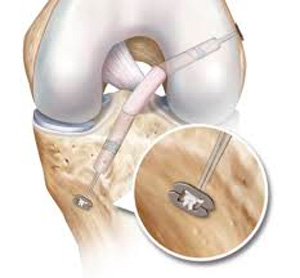Anterior Cruciate Ligament Reconstruction
- Home
- Treatments
- Anterior Cruciate Ligament Reconstruction
Anterior cruciate ligament reconstruction
The anterior cruciate ligament (ACL) is an intraarticular structure which, along with other knee ligaments, gives stability to this joint, mainly in its forward displacement. It usually gets torn during a sport activity, after a forced twisting of the knee. At the time of the injury, the patient usually hears a crack and feels the knee “giving way”, with severe pain and swelling.


The diagnosis is confirmed by magnetic resonance imaging (MRI)
If for any reason the tear remains undiagnosed and, once the initial pain and swelling go away, the patient continues his normal life, they probably will feel that the knee gives way or pop out of place, and they will not be able to perform certain movements, like pivoting or jumping.
The treatment consists of a reconstruction of the ACL. For this purpose, a graft with similar features to the initial ACL must be fashioned and positioned in the original placement.
There are several anatomic structures of the patient’s own body that can be used for fashioning the graft, like the hamstring tendons or the patellar tendon, depending on the surgeon’s preference and the patient’s needs.
At Clínica Adler we prefer to use the hamstring tendons (from the semitendinosus and gracilis muscles) from the patient’s own knee, which are harvested through a small incision at the anteromedial part of the leg. The reconstruction is a complex technique that is performed by arthroscopy and that requires an attachment of the graft in the exact original direction, through bone tunnels placed in the tibia and the femur.
The result depends on both the accuracy of the technique and the postoperative rehabilitation. The tendinous graft has to heal within the bone tunnels in a bone-graft junction, and needs to transform in a ligamentous structure. This is a long process, which is why we recommend our patients to postpone any risk activity at least until eight months after the surgery. During this time the patient has to follow an intense physiotherapy program, including knee mobility, muscle strengthening and propioception. Controlled and progressive biking, swimming and running are allowed. Around the third month normal life may be resumed, avoiding sudden twists of the knee until the eighth month.
Although most of the patients are young, this treatment may be necessary at any age, since older people practice sports too. Special mention should be made of the ACL injury in children and adolescents, where the growth plates are still opened. In the past it was said that the treatment had to be delayed until the closing of the plates to avoid their damage. Nowadays, however, we know that an unreconstructed ACL results in an increased risk of serious damage of other knee structures, like the cartilage or the menisci. Fortunately, proper techniques have been developed for these young patients.

ACL graft rupture
Similarly to the original ligament, the graft can get broken after a forced twist, or can fail after some years of good result. The patient feels the same symptoms of an ACL tear: the knee “gives way”.
In these cases, a comprehensive study is made, including physical examination, MRI, long leg radiographs and CT scan in order to determine why the graft has failed, which allows us to plan the right intervention. Generally, they need complex solutions, and often a two stages procedure is required.

